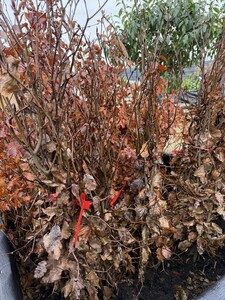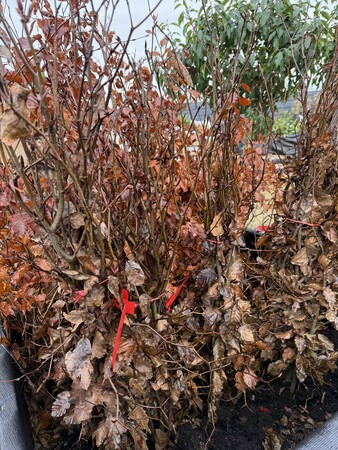Bareroot Fagus sylvatica 'Atropunicea' 80- 100cm
Please enter your email address below to be notified when the item is back in stock.
 Support Local Businesses
Support Local Businesses Dispatched within 1-4 working days
Dispatched within 1-4 working days
Bareroot Fagus sylvatica 'Atropunicea' 80- 100cm
Please enter your email address below to be notified when the item is back in stock.
 Support Local Businesses
Support Local Businesses Dispatched within 1-4 working days
Dispatched within 1-4 working days

Overview of Fagus sylvatica 'Atropunicea'
Fagus sylvatica 'Atropunicea', commonly called Purple Beech, is a striking deciduous tree or shrub known for its deep purple foliage and elegant, smooth gray bark. This variety of European Beech is widely used in hedging and as a standalone ornamental feature due to its colorful leaves and attractive winter structure. When grown from bareroot stock, this plant establishes quickly during the dormant season and makes a superb addition to any garden or landscape design, reaching heights of up to 5-10 meters over time. With proper care, Purple Beech can create a dense, formal hedge or a beautiful solitary tree.
Planting and Soil Requirements
- Planting Season: Plant bareroot Fagus sylvatica 'Atropunicea' from late autumn to early spring (November to March) when the tree is dormant. This timing helps ensure root establishment before the warmer growing season.
- Soil Type: This beech variety prefers well-draining loamy, sandy, or clay soil. Beech trees can handle a variety of soil types, but they do best in fertile, moisture-retentive soil.
- Soil pH: Ideally, Fagus sylvatica thrives in slightly acidic to neutral soil (pH 5.0–7.0). If your soil is highly acidic, consider adding lime to adjust the pH.
- Planting Depth: Ensure that the plant is placed at the same depth it was grown in the nursery. Look for a soil line on the stem and plant to that depth.
- Spacing: For a dense hedge, space plants about 30-50cm apart. For individual specimen trees, provide at least 2-3 meters of spacing around each tree to allow it room to grow.
Light Requirements
- Full Sun: Fagus sylvatica 'Atropunicea' performs best in full sunlight, which enhances the deep purple color of its foliage.
- Partial Shade: This tree can tolerate partial shade, although too much shade may lead to a less intense foliage color.
- Positioning in Hedge Rows: When planting for a hedge, ensure that the hedge row gets good sunlight exposure, as this will promote even growth and enhance leaf color.
Watering and Humidity
- Watering After Planting: Water thoroughly after planting to help establish roots. Continue watering regularly, especially during dry spells, in the first growing season.
- Drought Tolerance: Once established, Purple Beech is moderately drought-tolerant. However, consistent moisture is needed during the establishment phase, and occasional watering is helpful during extended dry periods.
- Humidity Requirements: Beech trees are not especially sensitive to humidity, making them adaptable to various climates. In hot, dry summers, regular watering can keep leaves looking healthy.
Fertilizing
- Fertilizer Type: Use a balanced, slow-release fertilizer or a specialized tree and shrub fertilizer (e.g., 10-10-10) in early spring to encourage new growth.
- Application Timing: Fertilize once a year in early spring as new growth begins, and then again in late autumn if the soil is poor.
- Organic Amendments: Adding a layer of compost or well-rotted manure around the base can improve soil fertility and support healthy root development.
Temperature and Climate
- Temperature Range: Fagus sylvatica 'Atropunicea' is hardy in USDA zones 5-8, tolerating cold winters and mild to warm summers.
- Cold Tolerance: This tree handles cold climates well, making it suitable for regions with harsh winters. It requires a period of winter dormancy.
- Heat Sensitivity: Although it can tolerate mild heat, Purple Beech may struggle in excessively hot, dry climates. In such regions, provide extra water during peak summer months to reduce stress.
Pruning and Maintenance
- Pruning Time: Prune in late winter or early spring before new growth begins. This allows the plant to direct its energy into shaping and filling out.
- Shaping for Hedges: When used as a hedge, prune regularly to encourage dense, even growth. Trim back side branches and shape the hedge to your preferred height.
- Selective Pruning: If grown as an ornamental tree, limit pruning to removing dead or crossing branches to maintain a natural shape.
- Long-term Maintenance: Once established, Fagus sylvatica requires little maintenance beyond annual pruning. Its slow growth makes it ideal for a low-maintenance hedge.
Pest and Disease Control
- Common Pests: Purple Beech may occasionally attract aphids, scale insects, or caterpillars, but these are rarely problematic. For minor infestations, a gentle spray of water or insecticidal soap is effective.
- Disease Resistance: While fairly disease-resistant, Purple Beech can be affected by fungal infections like powdery mildew, especially in humid climates. Ensure proper spacing and air circulation to prevent such issues.
- Preventive Measures: Regularly inspect for pests and diseases and remove any affected foliage. Avoid overhead watering, as this can create damp conditions that encourage fungal growth.
Benefits and Uses
- Ornamental Appeal: With its rich purple foliage, Purple Beech is a stunning focal point in gardens, providing color and interest throughout the growing season.
- Hedging Potential: Due to its dense growth and manageable size, this beech variety is a popular choice for formal hedging, adding structure and privacy.
- Wildlife Habitat: The dense branches offer shelter for small birds, and the foliage and bark attract beneficial insects, supporting garden biodiversity.
Troubleshooting Common Issues
- Poor Leaf Color: If foliage appears faded, this could indicate insufficient sunlight. Moving to a sunnier location or adjusting nearby shade can help.
- Stunted Growth: Slow or stunted growth may result from compacted or poorly drained soil. Improve soil aeration or amend with organic matter if needed.
- Wilting or Yellowing Leaves: This may indicate overwatering or poor drainage. Check soil moisture levels and adjust watering practices as necessary.
Additional Tips
- Mulching: A layer of mulch around the base helps retain soil moisture, suppress weeds, and maintain a stable root environment. Keep mulch away from the trunk to avoid rot.
- Wind Resistance: Purple Beech can tolerate wind, but avoid planting in exposed locations where strong winds could cause physical damage.
- Spacing for Hedges: Plant closely (30-50cm apart) to form a dense hedge. Space further for larger, free-standing trees to allow for natural growth and shape.
Summary of Care
- Soil: Well-draining, fertile soil with a slightly acidic to neutral pH.
- Light: Full sun to partial shade; full sun enhances the rich purple color.
- Water: Keep soil moist during the first growing season, then water as needed in dry periods.
- Temperature: Hardy in USDA zones 5-8, suitable for cold climates and mild summers.
- Fertilizer: Balanced fertilizer in spring and, if needed, in late autumn.
Conclusion
Fagus sylvatica 'Atropunicea' is a versatile and eye-catching choice for both hedging and ornamental use. With its dark purple leaves and dense growth habit, it brings color, structure, and privacy to gardens and landscapes. Its relatively low maintenance needs, combined with its resilience in a range of conditions, make it an ideal option for gardeners seeking an attractive, hardy, and easy-to-care-for plant. By following basic care guidelines—such as planting in well-drained soil, pruning annually, and ensuring adequate sunlight—you can enjoy a vibrant and healthy Purple Beech for years to come
|
Standard Delivery per parcel* |
€6.95 |
|
* parcels up to 30kg or within dimensions volume |
|
|
* free delivery over €250 on standard items (excludes large/bulky items) |
|
|
* multiple purchases qualify for combined delivery |
|
|
For large items please ring us on 069-64084 to discuss delivery. |
|
We currently only deliver within the island of Ireland, other countries can be quoted for by contacting info@dandmgardencentre.ie or via telephone on 06964084
Standard Delivery is FREE on orders over €250*
All standard deliveries will be completed within 5-7 working days via Fastway Couriers, any delay to this delivery time, the customer will be notified by One of our staff.
The in-Store delivery charge will vary compared with online, in-store delivery charge is done on a case by case basis.
* Only mainland Ireland addresses qualify for free delivery.
Live Plants Delivery
Our live plants are packed with care and diligence by our staff, our horticulturists review each plant before despatch to ensure quality is maintained.
Live Plant delivery charges are not calculated on weight but on the space required per package to ensure safe delivery, so delivery charges may vary as some plants require more space than others when packed.
All live plants are despatched within 3-5 working days where possible, our couriers aim to deliver within 48 hours of despatch from our Garden Centre to allow the plant to arrive in healthy condition.
Click & Collect
Can’t wait for delivery? Why not try our FREE Click & Collect service? Simply make your purchase online and collect it from our store located in Croagh Co. Limerick. Our staff will contact you by phone when your order is ready for collection (Please allow 24 hours minimum). When collecting your item, call the store on 069-64084. We will then load into your car as required. This service is available in-store 9am – 6pm Monday – Saturday (No collections on Sundays)
Click here for more information about our shipping conditions.
You can pay your online order either by credit card or via Paypal.
If you have any further questions about the online order payment please contact us via 069 640 84 or mail.
Are you looking for %name"? We offer this product in our garden centre in Ballycannon, Croagh, near Kilmallock, Charleville, Limerick, Adare and Ballingarry. You can order Bareroot Fagus sylvatica 'Atropunicea' 80- 100cm online or you can visit our garden centre in Ballycannon, Croagh, Limerick for more information about the product "Bareroot Fagus sylvatica 'Atropunicea' 80- 100cm". We look forward to seeing you soon!
Write a review about "Bareroot Fagus sylvatica 'Atropunicea' 80- 100cm"
We want to know your opinion! Write a review about the product “Bareroot Fagus sylvatica 'Atropunicea' 80- 100cm”

